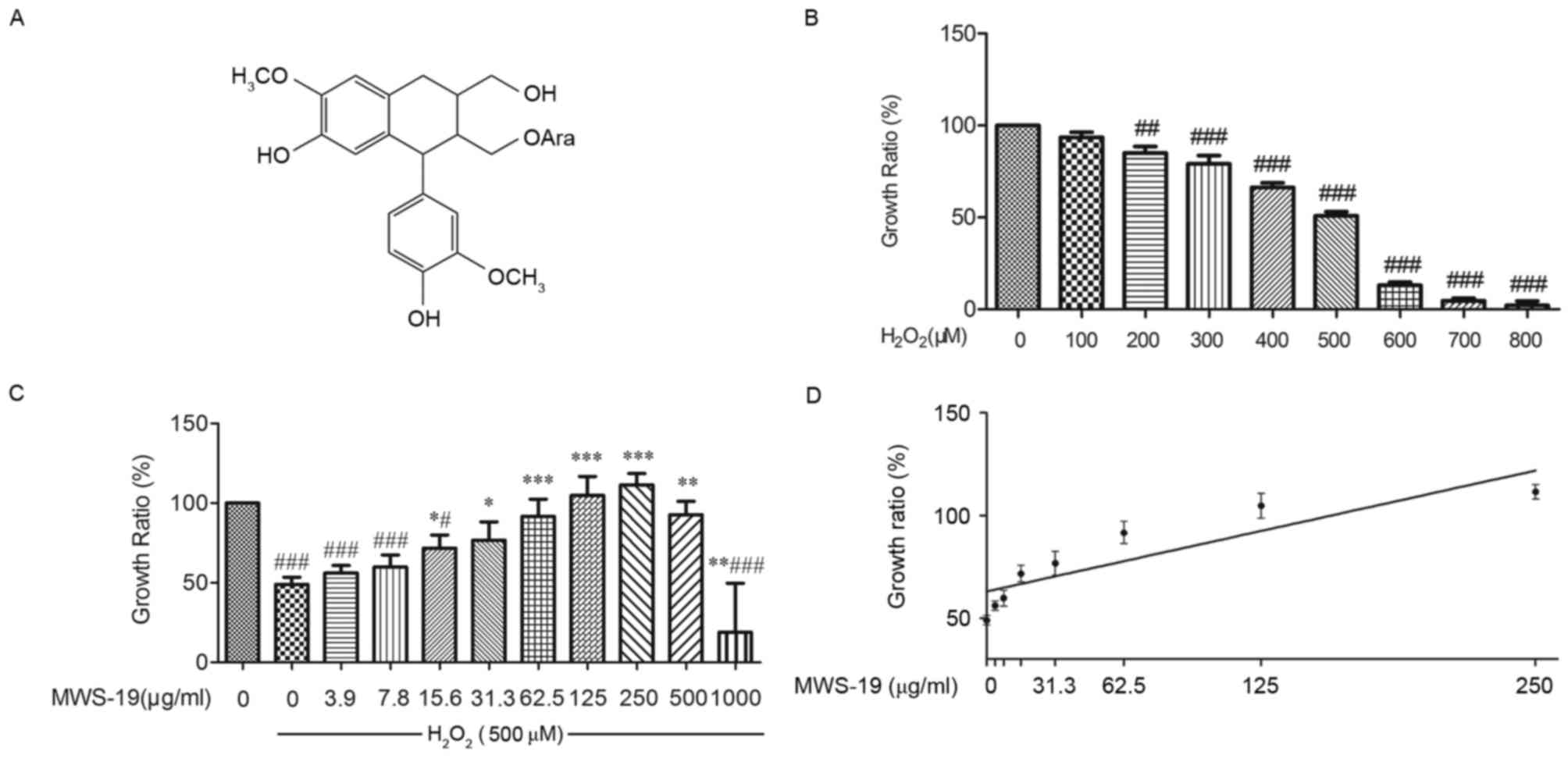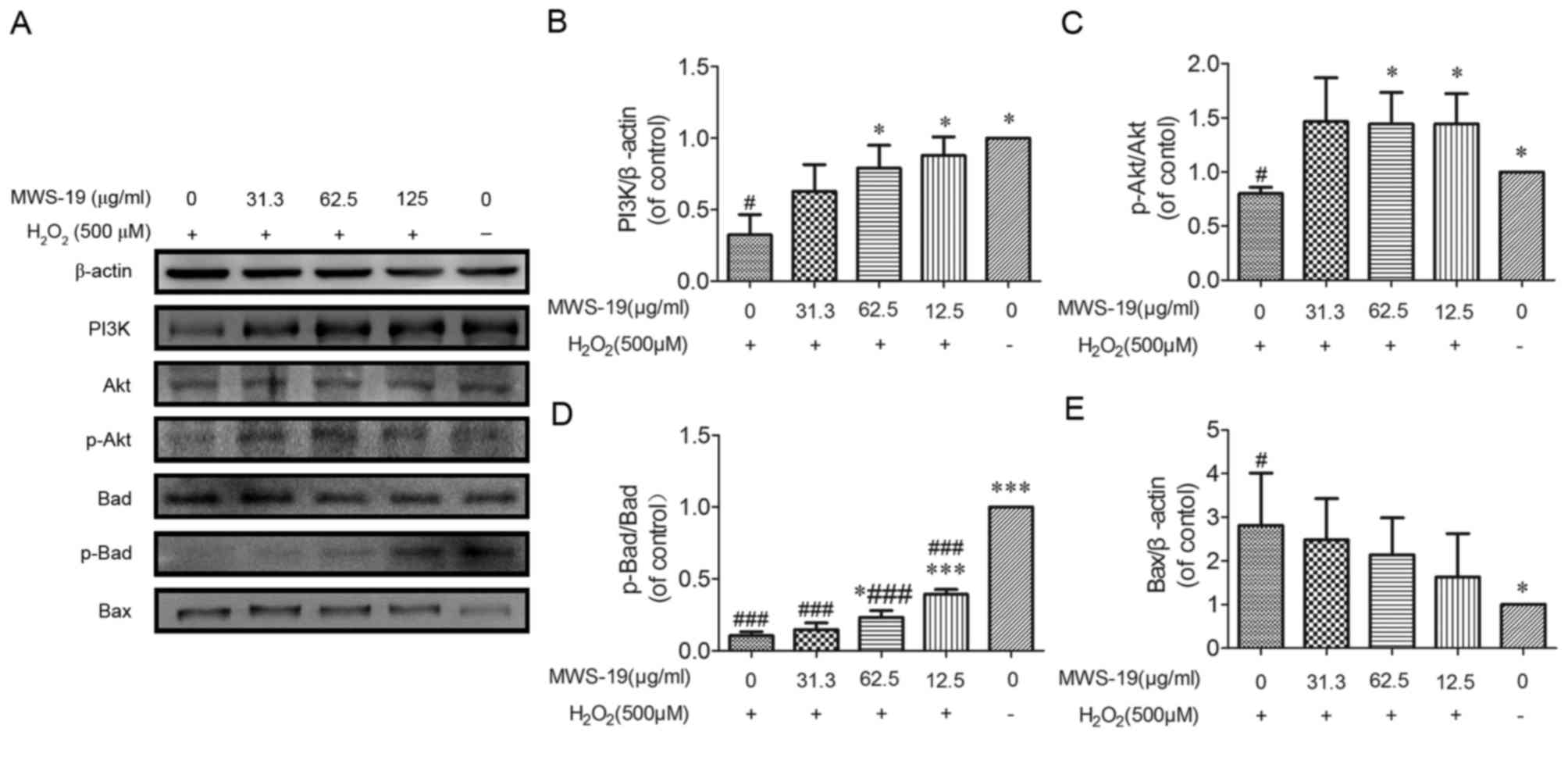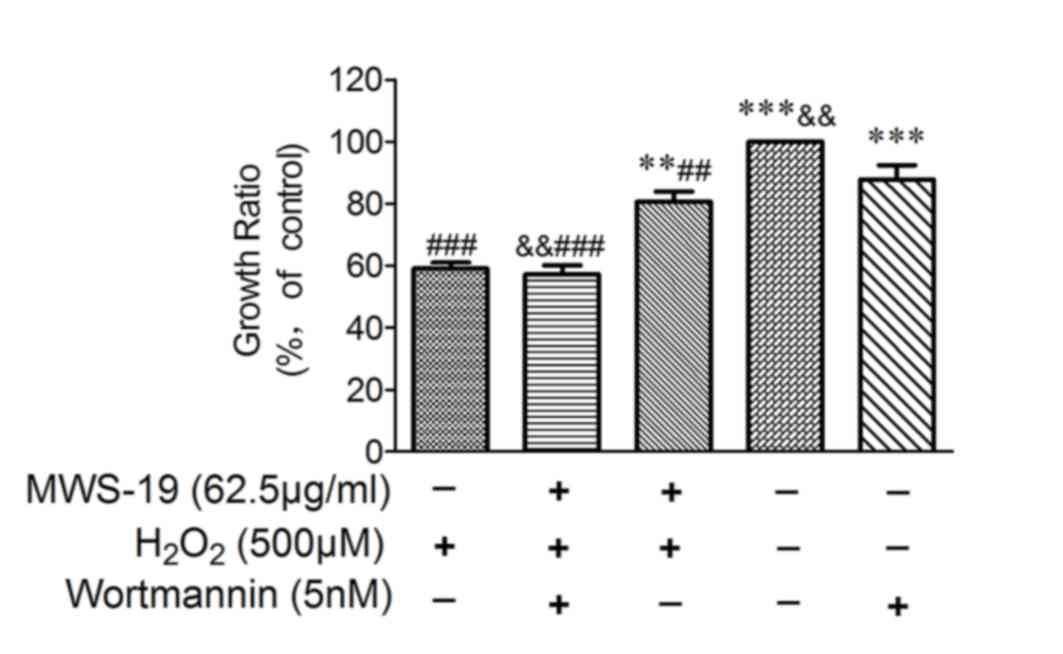|
1
|
Sui XQ, Xu ZM, Xie MB and Pei DA:
Resveratrol inhibits hydrogen peroxide-induced apoptosis
inendothelial cells via the activation of pi3k/akt by mir-126. J
Atheroscler Thromb. 21:108–118. 2014. View Article : Google Scholar : PubMed/NCBI
|
|
2
|
Oliveira-Paula GH, Lacchini R, Luizon MR,
Fontana V, Silva PS, Biagi C and Tanus-Santos JE: Endothelial
nitric oxide synthase tagsnps influence the effects of enalapril in
essential hypertension. Nitric Oxide. 55–56:62–69. 2016. View Article : Google Scholar
|
|
3
|
Chu P, Han GZ, Ahsan A, Sun ZW, Liu SM,
Zhang Z, Sun B, Song YL, Lin Y, Peng JY and Tang ZY:
Phosphocreatine protects endothelial cells from methylglyoxal
induced oxidative stress and apoptosis via the regulation of
pi3k/akt/enos and nf-kappab pathway. Vascular Pharmacol. 91:26–35.
2017. View Article : Google Scholar
|
|
4
|
Choi H, Tostes RC and Webb RC:
Mitochondrial aldehyde dehydrogenase prevents ros-induced vascular
contraction in angiotensin-ii hypertensive mice. J Am Soc Hyperten.
5:154–160. 2011. View Article : Google Scholar
|
|
5
|
Sakata K, Kondo T, Mizuno N, Shoji M,
Yasui H, Yamamori T, Inanami O, Yokoo H, Yoshimura N and Hattori Y:
Roles of ros and pkc-betaii in ionizing radiation-induced enos
activation in human vascular endothelial cells. Vascular Pharmacol.
70:55–65. 2015. View Article : Google Scholar
|
|
6
|
Chen S, Tang Y, Qian Y, Chen R, Zhang L,
Wo L and Chai H: Allicin prevents h2o2-induced apoptosis of huvecs
by inhibiting an oxidative stress pathway. BMC Complem Altern Med.
14:3212014. View Article : Google Scholar
|
|
7
|
Campos J, Schmeda-Hirschmann G, Leiva E,
Guzmán L, Orrego R, Fernández P, González M, Radojkovic C, Zuñiga
FA, Lamperti L, et al: Lemon grass (cymbopogon citratus (d.C)
stapf) polyphenols protect human umbilical vein endothelial cell
(huvecs) from oxidative damage induced by high glucose, hydrogen
peroxide and oxidised low-density lipoprotein. Food Chem.
151:175–181. 2014. View Article : Google Scholar : PubMed/NCBI
|
|
8
|
Li J, Feng X, Ge R, Li J and Li Q:
Protective effect of 2,4′,5′-trihydroxyl-5,2′-dibromo
diphenylmethanone, a new halophenol, against hydrogen
peroxide-induced EA.hy926 cells injury. Molecules. 20:14254–14264.
2015. View Article : Google Scholar : PubMed/NCBI
|
|
9
|
Yin Y, Wan J, Li P, Jia Y, Sun R, Pan G
and Wan G: Protective effect of Xin Mai Jia ultrafiltration extract
on human umbilical vein endothelial cell injury induced by hydrogen
peroxide and the effect on the No-cGMP signaling pathway. Exp Ther
Med. 8:38–48. 2014. View Article : Google Scholar : PubMed/NCBI
|
|
10
|
Patel H, Chen J and Kavdia M: Induced
peroxidase and cytoprotective enzyme expressions support adaptation
of HUVECs to sustain subsequent H2O2 exposure. Microvasc Res.
103:1–10. 2016. View Article : Google Scholar : PubMed/NCBI
|
|
11
|
Wang Z, Wang Y, Chen Y and Lv J: The IL-24
gene protects human umbilical vein endothelial cells against
H2O2-induced injury and may be useful as a
treatment for cardiovascular disease. Int J Mol Med. 37:581–592.
2016. View Article : Google Scholar : PubMed/NCBI
|
|
12
|
Liu X, Zhang GX, Zhang XY, Xia WH, Yang Z,
Su C, Qiu YX, Xu SY, Zhan H and Tao J: Lacidipine improves
endothelial repair capacity of endothelial progenitor cells from
patients with essential hypertension. Int J Cardiol. 168:3317–3326.
2013. View Article : Google Scholar : PubMed/NCBI
|
|
13
|
Ding X, Wang D, Li L and Ma H:
Dehydroepiandrosterone ameliorates H2O2-induced leydig cells
oxidation damage and apoptosis through inhibition of ROS production
and activation of PI3K/Akt pathways. Int J Biochem Cell Biol.
70:126–139. 2016. View Article : Google Scholar : PubMed/NCBI
|
|
14
|
Yang XC, Xiong XJ, Yang GY, Wang HR and
Wang J: Songling Xuemaikang capsule () for primary hypertension: A
systematic review of randomized controlled trials. Chin J Integr
Med. 21:312–320. 2015. View Article : Google Scholar : PubMed/NCBI
|
|
15
|
Xiao YC, Zhao XX, Yan CQ, Wang W, Huang
QS, Liang K, Meng BH, Ke X and YE L: Studies on chemical
constituents from fresh pineneedles of Pinus massoniana.
Chin Traditional Herbal Drugs. 46:3460–3465. 2015.
|
|
16
|
Bernini R, Gualandi G, Crestini C,
Barontini M, Belfiore MC, Willför S, Eklund P and Saladino R: A
novel and efficient synthesis of highly oxidized lignans by a
methyltrioxorhenium/hydrogen peroxide catalytic system. Studies on
their apoptogenic and antioxidant activity. Bioorg Med Chem.
17:5676–5682. 2009. View Article : Google Scholar : PubMed/NCBI
|
|
17
|
Chun JN, Cho M, So I and Jeon JH: The
protective effects of schisandra chinensis fruit extract and its
lignans against cardiovascular disease: A review of the molecular
mechanisms. Fitoterapia. 97:224–233. 2014. View Article : Google Scholar : PubMed/NCBI
|
|
18
|
Durazzo A, Turfani V, Azzini E, Maiani G
and Carcea M: Phenols, lignans and antioxidant properties of legume
and sweet chestnut flours. Food Chem. 140:666–671. 2013. View Article : Google Scholar : PubMed/NCBI
|
|
19
|
Newairy AS and Abdou HM: Protective role
of flax lignans against lead acetate induced oxidative damage and
hyperlipidemia in rats. Food Chem Toxicol. 47:813–818. 2009.
View Article : Google Scholar : PubMed/NCBI
|
|
20
|
Kanehira T, Takekoshi S, Nagata H,
Matsuzaki K, Kambayashi Y, Osamura RY and Homma T: A novel and
potent biological antioxidant, kinobeon a, from cell culture of
safflower. Life Sci. 74:87–97. 2003. View Article : Google Scholar : PubMed/NCBI
|
|
21
|
Ren Y, Tao S, Zheng S, Zhao M, Zhu Y, Yang
J and Wu Y: Salvianolic acid B improves vascular endothelial
function in diabetic rats with blood glucose fluctuations via
suppression of endothelial cell apoptosis. Eur J Pharmacol.
791:308–315. 2016. View Article : Google Scholar : PubMed/NCBI
|
|
22
|
Peng H, Chen L, Huang X, Yang T, Yu Z,
Cheng G, Zhang G and Shi R: Vascular peroxidase 1 up regulation by
angiotensin II attenuates nitric oxide production through
increasing asymmetrical dimethylarginine in HUVECs. J Am Soc
Hypertens. 10:741–751.e3. 2016. View Article : Google Scholar : PubMed/NCBI
|
|
23
|
Ni L, Li T, Liu B, Song X, Yang G, Wang L,
Miao S and Liu C: The protective effect of Bcl-xl overexpression
against oxidative stress-induced vascular endothelial cell injury
and the role of the Akt/eNOS pathway. Int J Mol Sci.
14:22149–22162. 2013. View Article : Google Scholar : PubMed/NCBI
|
|
24
|
Zhou M, Song X, Huang Y, Wei L, Li Z, You
Q, Guo Q and Lu N: Wogonin inhibits H2O2-induced angiogenesis via
suppressing PI3K/Akt/NF-κb signaling pathway. Vascu Pharmacol.
60:110–119. 2014. View Article : Google Scholar
|
|
25
|
Qin W, Ren B, Wang S, Liang S, He B, Shi
X, Wang L, Liang J and Wu F: Apigenin and naringenin ameliorate
PKCβII-associated endothelial dysfunction via regulating
ROS/caspase-3 and no pathway in endothelial cells exposed to high
glucose. Vascul Pharmacol. 85:39–49. 2016. View Article : Google Scholar : PubMed/NCBI
|
|
26
|
Fang LH, Chen BA, Liu SL, Wang RP, Hu SY,
Xia GH, Tian YL and Cai XH: Synergistic effect of a combination of
nanoparticulate Fe3O4 and gambogic acid on phosphatidylinositol
3-kinase/Akt/Bad pathway of LOVO cells. Int J Nanomed. 7:4109–4118.
2012.
|
|
27
|
Zhang H, Xiong Z, Wang J, Zhang S, Lei L,
Yang L and Zhang Z: Glucagon-like peptide-1 protects cardiomyocytes
from advanced oxidation protein product-induced apoptosis via the
PI3K/Akt/Bad signaling pathway. Mol Med Rep. 13:1593–1601. 2016.
View Article : Google Scholar : PubMed/NCBI
|














